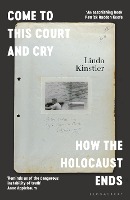'A tremendous feat of storytelling, propelled by numerous twists and revelations, yet anchored by a deep moral seriousness . . . Enthralling' Guardian
'Part detective story, part family history, part probing inquiry into how best to reckon with the horrors of a previous century, Come to This Court and Cry is bracingly original, beautifully written and haunting. An astonishing book' Patrick Radden Keefe, author of Empire of Pain
To probe the past is to submit the memory of one's ancestors to a certain kind of trial. In this case, the trial came to me.
A few years ago Linda Kinstler discovered that a man fifty years dead - a former Nazi who belonged to the same killing unit as her grandfather - was the subject of an ongoing criminal investigation in Latvia. The proceedings threatened to pardon his crimes. They put on the line hard-won facts about the Holocaust at the precise moment that the last living survivors - the last legal witnesses - were dying.
Across the world, Second World War-era cases are winding their way through the courts. Survivors have been telling their stories for the better part of a century, and still judges ask for proof. Where do these stories end? What responsibilities attend their transmission, so many generations on? How many ghosts need to be put on trial for us to consider the crime scene of history closed?
In this major non-fiction debut, Linda Kinstler investigates both her family story and the archives of ten nations to examine what it takes to prove history in our uncertain century. Probing and profound, Come to this Court and Cry is about the nature of memory and justice when revisionism, ultra-nationalism and denialism make it feel like history is slipping out from under our feet. It asks how the stories we tell about ourselves, our families and our nations are passed down, how we alter them, and what they demand of us.
'Kinstler reminds us of the dangerous instability of truth and testimony, and the urgent need, in the twenty-first century, to keep telling the history of the twentieth' Anne Applebaum
'A masterpiece' Peter Pomerantsev

